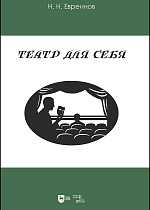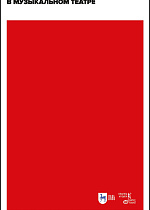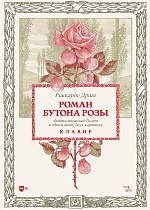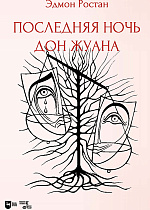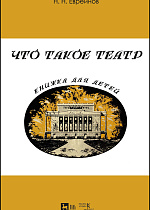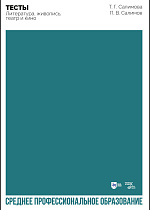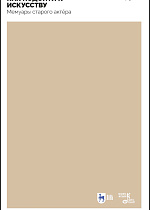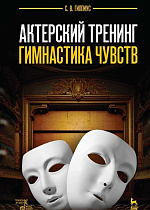История театра - все книги по дисциплине. Издательство Лань
Сохранить список:
Excel
Excel
Закрыть
Выгрузка списка книг доступна только авторизованным пользователям. Авторизоваться
Н. Н. Евреинов (1879–1953) — русский и французский режиссёр, драматург, создатель оригинальной теории театра, историк театрального искусства, философ и актёр, музыкант, художник и психолог.
Эта книга — театр, а точнее — буквенное представление в 3-х частях с дивертисментом напоследок. Содержание данного произведения сводится к показанию такого рода театральных представлений, которые, основываясь не столько на эстетическом чувстве, сколько на инстинкте преображения, являют радость. Книга впервые увидела свет в 1916 г.
Издание адресовано студентам театральных учебных заведений, педагогам, а также широкому кругу любителей театрального искусства.
N. N. Evreinov (1879–1953) was a Russian and French director, playwright, creator of an original theory of theater, theater historian, philosopher and actor, musician, artist, and psychologist.
This book is a theater, or rather a literal performance in 3 parts with a divertissement at the end. The content of this work comes down to showing such theatrical performances, which, based not so much on aesthetic feeling as on the instinct of transformation, represent the joy. The book was first published in 1916.
The edition is intended for students of theater schools, teachers, children, and a wide circle of theater art lovers.
Эта книга — театр, а точнее — буквенное представление в 3-х частях с дивертисментом напоследок. Содержание данного произведения сводится к показанию такого рода театральных представлений, которые, основываясь не столько на эстетическом чувстве, сколько на инстинкте преображения, являют радость. Книга впервые увидела свет в 1916 г.
Издание адресовано студентам театральных учебных заведений, педагогам, а также широкому кругу любителей театрального искусства.
N. N. Evreinov (1879–1953) was a Russian and French director, playwright, creator of an original theory of theater, theater historian, philosopher and actor, musician, artist, and psychologist.
This book is a theater, or rather a literal performance in 3 parts with a divertissement at the end. The content of this work comes down to showing such theatrical performances, which, based not so much on aesthetic feeling as on the instinct of transformation, represent the joy. The book was first published in 1916.
The edition is intended for students of theater schools, teachers, children, and a wide circle of theater art lovers.
Георгий Павлович Ансимов (1922–2015) — одна из вершин мировой оперно-музыкальной режиссуры. За свою творческую жизнь поставил более ста спектаклей — в России, СССР, Чехии, Австрии, Германии, Китае, Корее, в Прибалтике. С 1954 года преподавал в ГИТИСе, воспитав целую плеяду выдающихся мастеров музыкального театра, его ученики и по сей день блистают на сценах самых знаковых театров мира.
Настоящая книга, жанр которой не так легко определить, приоткрывает завесу творческой деятельности режиссера, повествующего в увлекательной манере о своей работе в музыкальном театре. Автор делится размышлениями, воспоминаниями, меткими аналитическими наблюдениями о постановках «Фра-Дьяволо», «Укрощение строптивой», «Орфей в аду», «Фиалка Монмартра», «Война и мир» и др.
Соответствует современным требованиям Федерального государственного образовательного стандарта среднего профессионального образования и профессиональным квалификационным требованиям. Пособие предназначено для студентов и преподавателей средних специальных учебных заведений.
Georgy Pavlovich Ansimov (1922–2015) is one of the world’s most prominent opera and music directors. Throughout his career, he staged more than a hundred performances in Russia, the USSR, the Czech Republic, Austria, Germany, China, Korea, and the Baltics. Since 1954, he taught at GITIS, having trained a galaxy of outstanding masters of music theatre; his students still shine on the stages of the world’s most iconic theatres.
This book, the genre of which is not so easy to define, lifts the curtain on the director’s method. In a fascinating manner he tells about his work in the music theatre. The author shares his thoughts, memories, keen analytical observations on the productions of Fra Diavolo, The Taming of the Shrew, Orpheus in the Underworld, The Violet of Montmartre, War and Peace and others.
Corresponds to the modern requirements of the Federal State Educational Standard of Secondary Vocational Education and professional qualification requirements.The textbook is intended for teachers and students of colleges.
Настоящая книга, жанр которой не так легко определить, приоткрывает завесу творческой деятельности режиссера, повествующего в увлекательной манере о своей работе в музыкальном театре. Автор делится размышлениями, воспоминаниями, меткими аналитическими наблюдениями о постановках «Фра-Дьяволо», «Укрощение строптивой», «Орфей в аду», «Фиалка Монмартра», «Война и мир» и др.
Соответствует современным требованиям Федерального государственного образовательного стандарта среднего профессионального образования и профессиональным квалификационным требованиям. Пособие предназначено для студентов и преподавателей средних специальных учебных заведений.
Georgy Pavlovich Ansimov (1922–2015) is one of the world’s most prominent opera and music directors. Throughout his career, he staged more than a hundred performances in Russia, the USSR, the Czech Republic, Austria, Germany, China, Korea, and the Baltics. Since 1954, he taught at GITIS, having trained a galaxy of outstanding masters of music theatre; his students still shine on the stages of the world’s most iconic theatres.
This book, the genre of which is not so easy to define, lifts the curtain on the director’s method. In a fascinating manner he tells about his work in the music theatre. The author shares his thoughts, memories, keen analytical observations on the productions of Fra Diavolo, The Taming of the Shrew, Orpheus in the Underworld, The Violet of Montmartre, War and Peace and others.
Corresponds to the modern requirements of the Federal State Educational Standard of Secondary Vocational Education and professional qualification requirements.The textbook is intended for teachers and students of colleges.
Впервые предлагается издание клавира балета Риккардо Дриго «Роман Бутона розы». Балет в 1904 году готовился Мариусом Петипа для постановки в Эрмитажном театре, но так и не был показан зрителям, и современная публикация фортепианного переложения, сделанного самим композитором – редчайшая возможность познакомиться с музыкой неосуществленного спектакля.
Клавир дополнен текстом либретто, сочиненным Иваном Александровичем Всеволожским и Мариусом Петипа, а также научными статьями, посвященными жизни и творчеству Дриго, истории создания балета и особенностям его музыкальной драматургии.
Издание будет полезно хореографам и балетмейстерам-реставраторам, концертмейстерам балета, педагогам и учащимся хореографических учебных заведений, балетоведам, культуроведам и музыковедам, изучающим историю балета и балетной музыки, а также всем любителям балетного театра.
This is the first edition of a piano score of The Romance of a Rosebud, the ballet by Riccardo Drigo. The ballet was choreographed by Marius Petipa in 1904 for production at the Hermitage Theatre, but was never shown to the audience, and the current publication of the piano transcription made by the composer himself is a rare opportunity to get acquainted with the music of a lost performance.
The piano score is supplemented with the libretto written by Ivan Aleksandrovich Vsevolozhsky and Marius Petipa, as well as the researches’ articles devoted to the life and work of Drigo, the history of the ballet creation the features of its music dramaturgy.
The edition will be useful to choreographers and ballet restorers, ballet accompanists, teachers and students of choreographic schools, ballet experts, culture experts and musicologists studying the ballet history and ballet music history, as well as all admirers of ballet theatre.
Клавир дополнен текстом либретто, сочиненным Иваном Александровичем Всеволожским и Мариусом Петипа, а также научными статьями, посвященными жизни и творчеству Дриго, истории создания балета и особенностям его музыкальной драматургии.
Издание будет полезно хореографам и балетмейстерам-реставраторам, концертмейстерам балета, педагогам и учащимся хореографических учебных заведений, балетоведам, культуроведам и музыковедам, изучающим историю балета и балетной музыки, а также всем любителям балетного театра.
This is the first edition of a piano score of The Romance of a Rosebud, the ballet by Riccardo Drigo. The ballet was choreographed by Marius Petipa in 1904 for production at the Hermitage Theatre, but was never shown to the audience, and the current publication of the piano transcription made by the composer himself is a rare opportunity to get acquainted with the music of a lost performance.
The piano score is supplemented with the libretto written by Ivan Aleksandrovich Vsevolozhsky and Marius Petipa, as well as the researches’ articles devoted to the life and work of Drigo, the history of the ballet creation the features of its music dramaturgy.
The edition will be useful to choreographers and ballet restorers, ballet accompanists, teachers and students of choreographic schools, ballet experts, culture experts and musicologists studying the ballet history and ballet music history, as well as all admirers of ballet theatre.
Первый полный поэтический перевод на русский язык последней пьесы известного французского драматурга Эдмона Ростана (1868–1918). Автор знаменитого «Сирано де Бержерака», Ростан написал «Последнюю ночь Дон Жуана» в 1914 году, в преддверии Первой мировой войны. По-новому интерпретируя бродячий сюжет о великом повесе, совмещая элементы драматического и кукольного театров, трагедию и балаган, философию и фарс, автор дает совершенно неожиданную для читателей развязку традиционного сюжета.
This edition is the first full poetic Russian translation of the last play by the well-known French playwright Edmond Rostand (1868–1918). The author of the famous Cyrano de Bergerac, Rostand wrote The Last Night of Don Juan in 1914, on the eve of World War I. Reinterpreting the eternal plot of the great rake in a new way, combining elements of drama and puppet theatre, tragedy and booth, philosophy and farce, the author gives readers a completely unexpected ending of the traditional plot.
This edition is the first full poetic Russian translation of the last play by the well-known French playwright Edmond Rostand (1868–1918). The author of the famous Cyrano de Bergerac, Rostand wrote The Last Night of Don Juan in 1914, on the eve of World War I. Reinterpreting the eternal plot of the great rake in a new way, combining elements of drama and puppet theatre, tragedy and booth, philosophy and farce, the author gives readers a completely unexpected ending of the traditional plot.
Книга о блокаде советского актёра театра и кино, заслуженного артиста РСФСР Анатолия Королькевича (1901–1977) впервые была выпущена в 1965 году.
Автор, используя записи своего блокадного дневника, рассказывает о театре, о себе, о своих коллегах и зрителях — ленинградцах и фронтовиках, о спектаклях на сцене и концертах на передовой, в окопах, землянках, на аэродроме и в госпиталях.
Настоящее издание дополнено впервые опубликованными фотографиями из архива Санкт-Петербургского театра музыкальной комедии. В приложении представлен список премьер и возобновления спектаклей, осуществленные театром в годы Великой Отечественной Войны.
Предназначено для широкого круга читалей.
This book telling about the Leningrad siege and written by the Soviet theatre and film actor, Honored Artist of the RSFSR Anatoly Korolkevich (1901–1977) was first published in 1965. Basing on his siege diary, the author talks about the theatre, about himself, about his colleagues and spectators — Leningrad residents and front-line soldiers, about performances on stage and concerts at the front lines, in trenches, dugouts, at the airfield and in hospitals.
This edition is supplemented with photos from the archives of the St. Petersburg Musical Comedy Theatre, published for the first time. The appendix contains a list of premieres and revivals of performances, held by the theatre during the Great Patriotic War.
It is intended for a wide range of readers.
Автор, используя записи своего блокадного дневника, рассказывает о театре, о себе, о своих коллегах и зрителях — ленинградцах и фронтовиках, о спектаклях на сцене и концертах на передовой, в окопах, землянках, на аэродроме и в госпиталях.
Настоящее издание дополнено впервые опубликованными фотографиями из архива Санкт-Петербургского театра музыкальной комедии. В приложении представлен список премьер и возобновления спектаклей, осуществленные театром в годы Великой Отечественной Войны.
Предназначено для широкого круга читалей.
This book telling about the Leningrad siege and written by the Soviet theatre and film actor, Honored Artist of the RSFSR Anatoly Korolkevich (1901–1977) was first published in 1965. Basing on his siege diary, the author talks about the theatre, about himself, about his colleagues and spectators — Leningrad residents and front-line soldiers, about performances on stage and concerts at the front lines, in trenches, dugouts, at the airfield and in hospitals.
This edition is supplemented with photos from the archives of the St. Petersburg Musical Comedy Theatre, published for the first time. The appendix contains a list of premieres and revivals of performances, held by the theatre during the Great Patriotic War.
It is intended for a wide range of readers.
Н.Н. Евреинов (1879-1953) — русский и французский режиссёр, драматург, создатель оригинальной теории театра, историк театрального искусства, философ и актёр, музыкант, художник и психолог. По мнению Евреинова, главное в театре — иллюзия, которая в первую очередь должна быть создана игрой актёров, а не декорациями. Цель театра — реализовать идеальное и недосягаемое в жизни, не уходя при этом в обыденность.
Книга впервые вышла в 1921 году. Издание предназначается педагогам, детям, родителям, а также всем любителям театра.
N. N. Evreinov (1879–1953) was a Russian and French director, playwright, creator of an original theory of theater, theater historian, philosopher and actor, musician, artist, and
psychologist. According to Evreinov, the main thing in theater is an illusion, which should be created primarily by the actors’ play, not by the scenery. The theater’s aim is to embody the ideal and the unattainable things in life, without going into the routine.
The book was first published in 1921. The edition is intended for teachers, children, parents, and all theater lovers.
Книга впервые вышла в 1921 году. Издание предназначается педагогам, детям, родителям, а также всем любителям театра.
N. N. Evreinov (1879–1953) was a Russian and French director, playwright, creator of an original theory of theater, theater historian, philosopher and actor, musician, artist, and
psychologist. According to Evreinov, the main thing in theater is an illusion, which should be created primarily by the actors’ play, not by the scenery. The theater’s aim is to embody the ideal and the unattainable things in life, without going into the routine.
The book was first published in 1921. The edition is intended for teachers, children, parents, and all theater lovers.
Вашему вниманию предлагается сборник тестов, состоящий из более чем тысячи вопросов. Первый раздел посвящен общим вопросам географии, культуры, истории России и истории русской музыки, литературы, живописи, отечественного театра и кино. Остальные три раздела посвящены соответственно зарубежной литературе, живописи, театру и кино. Тесты прекрасно подойдут для подготовки к коллоквиумам, экзаменам и зачетам по направлениям «литературоведение», «киноведение», «искусствоведение», «театроведение», «режиссура», «актер театра и кино», а также «музыкальная журналистика», «музыковедение», «дирижирование», и будут весьма полезны не только выпускникам, абитуриентам и студентам, но и педагогам студий, специализированных школ, училищ и вузов.
Соответствует современным требованиям Федерального государственного образовательного стандарта среднего профессионального образования и профессиональным квалификационным требованиям.
Пособие предназначено для студентов и преподавателей средних специальных учебных заведений.
The current edition represents a collection of tests consisting of more than a thousand questions. The first section is devoted to general questions on geography, culture, history of Russia and the history of Russian music, literature, painting, Russian theatre and cinema. The other three sections are devoted to foreign literature, painting, theatre and cinema. Thе tests are perfect for getting ready for colloquiums, exams and tests in the following areas: “literary studies”, “film studies”, “arts studies”, “theatre studies”, “directing”, “theatre and film actor”, as well as “music journalism”, “musicology”, “conducting”, and will be quite useful not only for graduates, applicants and students, but also for teachers of studios, specialized schools, colleges and higher schools.
Corresponds to the modern requirements of the Federal State Educational Standard of Secondary Vocational Education and professional qualification requirements.
The textbook is intended for students and teachers of colleges.
Соответствует современным требованиям Федерального государственного образовательного стандарта среднего профессионального образования и профессиональным квалификационным требованиям.
Пособие предназначено для студентов и преподавателей средних специальных учебных заведений.
The current edition represents a collection of tests consisting of more than a thousand questions. The first section is devoted to general questions on geography, culture, history of Russia and the history of Russian music, literature, painting, Russian theatre and cinema. The other three sections are devoted to foreign literature, painting, theatre and cinema. Thе tests are perfect for getting ready for colloquiums, exams and tests in the following areas: “literary studies”, “film studies”, “arts studies”, “theatre studies”, “directing”, “theatre and film actor”, as well as “music journalism”, “musicology”, “conducting”, and will be quite useful not only for graduates, applicants and students, but also for teachers of studios, specialized schools, colleges and higher schools.
Corresponds to the modern requirements of the Federal State Educational Standard of Secondary Vocational Education and professional qualification requirements.
The textbook is intended for students and teachers of colleges.
Павел Павлович Дриго (1871–1952) – актёр, режиссёр, педагог, издатель, поэт. Потомок музыкально-театральной династии Лядовых. Дриго прослужил на провинциальной театральной сцене почти 50 лет. Он выходил на сцену вместе с В. Ф. Комиссаржевской, М. Г. Савиной, М. В. Дальским, В. П. Далматовым, А. А. Нильским. В книге описана театральная жизнь тех лет; представлен разбор классических пьес русского репертуара. В биографическом очерке, написанном Игорем Прохоровым — исследователем династии Лядовых, приведены сведения о Дриго и о его семье. В книге впервые публикуются фотографии из личных архивов потомков братьев Дриго.
Соответствует современным требованиям Федерального государственного образовательного стандарта среднего профессионального образования и профессиональным квалификационным требованиям.
Пособие проедназначено студентам и преподавателям средних специальных учебных заведений.
Pavel Pavlovich Drigo (1871–1952) was an actor, theatre director, educator, publisher, poet. Descendant of the Lyadov musical and theatrical dynasty. Drigo acted on the provincial towns theatre stage for almost 50 years. He went on stage together with V. F. Komis-sarzhevskaya, M. G. Savina, M. V. Dalsky, V. P. Dalmatov, A. A. Nilsky.
The author describes the theatrical life between the late 1880s and early 1900s, presents the analysis of classical plays of the Russian theatre repertoire. The biographical sketch written by Igor Prokhorov, a researcher of the Lyadov dynasty, gives information on Drigo and his family. The photos from the personal archives of the descendants of the Drigo brothers are published for the first time. Corresponds to the modern requirements of the Federal State Educational Standard of Secondary Vocational Education and professional qualification requirements.
The book is intended for students and teachers of colleges.
Соответствует современным требованиям Федерального государственного образовательного стандарта среднего профессионального образования и профессиональным квалификационным требованиям.
Пособие проедназначено студентам и преподавателям средних специальных учебных заведений.
Pavel Pavlovich Drigo (1871–1952) was an actor, theatre director, educator, publisher, poet. Descendant of the Lyadov musical and theatrical dynasty. Drigo acted on the provincial towns theatre stage for almost 50 years. He went on stage together with V. F. Komis-sarzhevskaya, M. G. Savina, M. V. Dalsky, V. P. Dalmatov, A. A. Nilsky.
The author describes the theatrical life between the late 1880s and early 1900s, presents the analysis of classical plays of the Russian theatre repertoire. The biographical sketch written by Igor Prokhorov, a researcher of the Lyadov dynasty, gives information on Drigo and his family. The photos from the personal archives of the descendants of the Drigo brothers are published for the first time. Corresponds to the modern requirements of the Federal State Educational Standard of Secondary Vocational Education and professional qualification requirements.
The book is intended for students and teachers of colleges.
Cергей Гиппиус (1924–1981) – театральный педагог, режиссер. Книга «Гимнастика чувств», впервые увидевшая свет в 1967 году, суммировала многолетний преподавательский опыт автора, одного из ведущих теоретиков и практиков актерского мастерства. Книга включает 400 упражнений на развитие актерской техники, ясно сформулированных и систематизированных.
Книга адресована актерам, режиссерам, студентам и преподавателям театральных учебных заведений, ведущим тренингов и всем интересующимся актерской игрой.
Книга адресована актерам, режиссерам, студентам и преподавателям театральных учебных заведений, ведущим тренингов и всем интересующимся актерской игрой.
Работа Кима Брейтбурга посвящена исследованию истории музыкального коммерческого театра Бродвея в контексте исторических и социокультурных особенностей, формировавших его генезис и дальнейшую эволюцию. Информация, содержащаяся в монографии, может быть полезна для специалистов, занимающихся исследованиями истории театра, созданием и сценической постановкой мюзиклов. Книга также адресована учащимся музыкальных и театральных коледжей и вузов, широкому кругу любителей жанра мюзикла.
The work by Kim Breitburg is devoted to the study of the Broadway musical commercial theater history in the context of the historical and sociocultural features that formed its genesis and further evolution. The information included in the monograph may be useful for specialists involved in the theater history research, the creation and stage production of musicals. The book is also addressed to students of music and theater colleges and higher schools, to a wide range of lovers of the musical genre.
The work by Kim Breitburg is devoted to the study of the Broadway musical commercial theater history in the context of the historical and sociocultural features that formed its genesis and further evolution. The information included in the monograph may be useful for specialists involved in the theater history research, the creation and stage production of musicals. The book is also addressed to students of music and theater colleges and higher schools, to a wide range of lovers of the musical genre.


